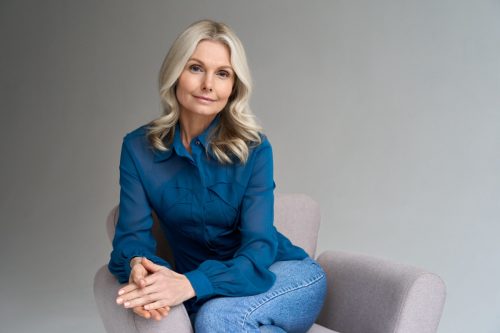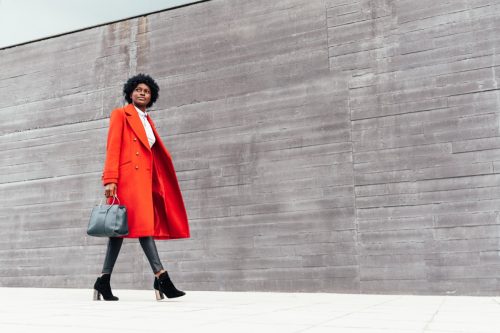How to Power Dress in 2024

Depending on your personal style, you may have different ideas of what it means to “dress to impress.” One of these approaches, however, is known as “power dressing,” a tactic best used when you want to communicate your confidence to those around you. It’s generally used in the workplace, but that’s certainly not the only sphere where you want to look and feel powerful. So, if you’ve ever wondered how to power dress, stylists have some recommendations.
“Dressing for success is not only for the career-minded. Wardrobe is one of our most powerful tools to command, attract, and persuade, which anyone can leverage,” says certified image stylist Elizabeth Kosich, founder of Elizabeth Kosich Styling. “It starts with aligning wardrobe to intentions, then knowing the colors, lines, shapes, and silhouettes that best support your personal goals.”
Ready to start power dressing this year? Read on for key tips to help you get started.
RELATED: 10 Tips for Getting Out of a Clothing Rut After 60, Stylists Say.
What is power dressing?

There are several definitions of power dressing, but it started as a trend for women in the workplace in the ’70s and ’80s. At the time, that may have been comprised of typical suits and shoulder pads so as to be taken “seriously,” but in 2024, women can take a different approach.
In fact, when dressing to convey confidence these days, it helps to intersperse your unique flair and style preferences.
RELATED: 10 Signs You Need to Get Your Clothing Tailored.
What are some general tips to power dress?
Consider your colors.

According to Kosich, deep, dark colors “communicate authority, power, and expertise,” making a dark neutral a reliable option for power dressing.
But while you may be under the impression that you need to move away from vivid colors, that’s not necessarily the case.
“Bright colors are assertive, though too bright upstages the wearer, so don’t go overboard,” Kosich cautions. “Cool hues tend to be reserved and intimidating, while head-to-toe monochrome lengthens, strengthens, and is the ultimate wardrobe power play.”
Integrate different fabrics.
Fabrics are another thing to keep in mind when dressing to make a strong statement.
“Even a material’s texture communicates a message,” Kosich shares. “Smooth, crisp and shiny qualities present as serious and polished, while textured, flowing and patterned fabrics project a more approachable, disarming and soft image.”
Don’t forget the details.
You may already have a few solid power dressing pieces, but to really elevate a look, you need to think about fit and accessories, i.e. the details.
“Details can make or break any outfit, and this is especially true when it comes to power dressing or making a personal style statement of any sort,” says Holly Chayes, personal style coach and consultant at Who Wears Who?
When it comes to accessories, Kosich recommends using them as the focal points for your outfits.
“To frame the face, try statement earrings, a bold lip, or a short necklace. Eyewear is another powerful tool that says a lot with very little, so choose heavy and angular frames for a studious and serious power look,” she suggests. “If showcasing your shape is the goal, draw attention to the waistline with a belt, V-neck, or three-quarter length sleeve.”
It’s always a tricky area with décolletage as well, but when in doubt, consider taking Kosich’s advice: “Less is more.”
RELATED: 10 Timeless Clothing Items That Never Go Out of Style.
Be mindful of structure.

Looking for pieces that have good structure is key—and this is another area where tailoring can really make or break a look.
“For those wanting a competitive edge, choose corners over curves,” Kosich advises. “Straight lines and sharp angles convey professionalism and authority, so always wear structured silhouettes like classic suiting, tailored shirting, and strongly defined shoulders to be taken seriously.”
Consider how you pair colors.
When playing with colors, another thing to keep in mind is how you wear them together, Kosich notes. If you want a look that’s “high-impact,” she recommends going for “high-contrast pairings.”
“Match a light value color with a dark value one like black with white or soft yellow, midnight navy with light beige or dove gray, and any jewel tone with optic white,” Kosich explains. “Also consider colors opposite each other on the color wheel, making sure one is a deep and dark value and its opposite is in the light and soft range.”
Think about what you’re power dressing for.
Before you shell out on an expensive blazer, think about what exactly you’ll be power dressing for and the people you’ll be surrounded by.
“Consider the situation, venue, and circumstances—what are your roles and responsibilities? What do you want your roles and responsibilities to be? Are there interpersonal dynamics you need or want to consider? Sometimes, power dressing can be as simple as throwing on your version of a power suit—other situations call for a little more finesse,” Chayes explains.
Still not sure what that outfit should look like? Think about your end goal and how you want to feel.
“If you’re looking to achieve a certain feeling (power, confidence, self-assurance, calm, centered, competent, etc.), name that feeling, and build your outfit towards that,” she says.
Identify your “A outfit” to build your wardrobe.

Even if you’re not actively power-dressing, chances are you have something in your closet that you pick out when you need to feel your best. Petite style coach Angela Foster calls this ensemble your “A outfit”—and it’s likely the one you’d pick out before a big meeting or presentation.
“It won that special ranking because it looks amazing. It’s comfortable and makes us feel confident, capable, and powerful,” Foster says. “Why wouldn’t we want to feel that way every day? We do, and we can.”
To build out your power dressing options and add more “A outfits” to your closet, ask yourself a few questions.
“What specifically do you love about it? Is it the fit of the jacket? Is it the length of the skirt? The blouse that adds a pop of color? It could be one thing or multiple characteristics,” Foster shares. “Either way, once we’re able to articulate it, we can duplicate their ‘A outfit’ over and over.”
RELATED: 8 Clothing Items That Make You Look Dated, Stylists Say.
How do I power dress for work?

Of course, work is still one of the places where we want to feel our best and like we’re putting our best foot forward. However, it’s also one of the trickier settings to dress for, according to Foster.
“Power dressing can be difficult to pin down because it looks different for every industry, every company, and even different departments inside the same company,” she notes. “For example, expectations for the social media team inside the marketing department look very different than the expectations for the HR or finance department inside the same company. However, it’s worth taking the time to figure it out. (Or to hire an expert to help you nail it down quickly.)”
So, when looking through your closet or shopping for new attire, figure in your responsibilities.
RELATED: The 6 Best Clothing Brands If You’re Over 60, Stylists Say.
What industry do you work in?
First and foremost, think about what sector you work in and take cues from those around you if need be.
“What’s considered appropriate largely depends on your industry,” Foster stresses. “When in doubt, look to your people leader or a peer who is well-established, respected, and has a stellar reputation. Especially if you’re looking to get promoted. If they always wear a third piece, like a blazer, jacket, or cardigan, following her lead is a savvy style move.”
Are you client-facing?
You also want to maintain relationships with your coworkers and superiors at the office, but if it’s part of your job description, Foster recommends considering how your clients perceive you.
“Strangers make 11 decisions about us in seven seconds. When sales are on the line, especially high-value, high-ticket services, dress as well or slightly better than the decision maker,” she explains. “Putting extra effort into our appearance sends the subconscious message, ‘I go the extra mile for my work, and I’ll do the same when taking care of your account.'”
RELATED: 5 Colors You Should Never Wear Together, Stylists Say.
Final Thoughts

Trying to dress a certain way or pick out pieces that convey a specific message can be overwhelming at first. That’s why stylists recommend taking small steps before revamping your entire wardrobe.
While you should make an appointment with your tailor if you have any fit issues, you can start by ensuring your outfits are cleaned and pressed.
“The message a wrinkled outfit sends is devastating,” Foster warns. “[It] causes others to think, ‘If the effort it takes to steam a blouse is too much, how much extra effort is she going to put into my account, project, etc.?'”
Then, when you’re ready to shop, go for quality over quantity—and identify a style that you can stick to.
“Choose the best quality your budget can afford. While the expense is initially more, the classic styles and quality fabrics and construction will save money in the long run,” Foster says. “Think of your career wardrobe as the teaser on the back of a book. Convince them to buy the novel, and you’ll have the chance to prove to them what a smart, powerful, best-selling leader you are.”